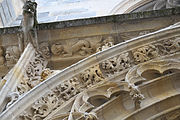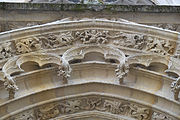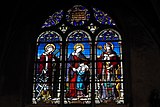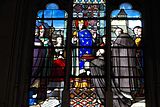St-Martin (Longjumeau)
The Catholic parish church of Saint-Martin in Longjumeau , a parish in the Essonne department in the French region of Île-de-France , was built in the mid-13th century in the Gothic style and rebuilt in the 15th century after a fire. In 1910, the church was added to the list of architectural monuments in France as Monument historique .
history
The patronage of St. Martin suggests that there was a place of worship on the site of today's parish church as early as the Merovingian era. The current church was built around 1250 under Hugues Piedoie, the builder of the French King Louis the Saint . The church was badly damaged during the Hundred Years War and was rebuilt in the 15th century. In 1730 the baptistery was added, in 1745 the sacristy was added . A fire in 1774 destroyed the upper floor of the bell tower. The church was restored several times in the 18th and 19th centuries. In 2011 the bell tower was completely renovated. It received a new slate roof and new sound lamellas made of oak. Also new, inspired by medieval models were corbels created.
architecture
West facade
The west facade is structured by four strong buttresses . In the middle, the main portal opens under a four-part tracery window, the archivolts of which are sculpted with three-pass arches and foliage. A cornice with gargoyles and a frieze of human heads, vine tendrils and dragon-like creatures runs above the portal . The side figure niches, the sculptures of which were destroyed during the wars of religion , are crowned with filigree canopies . Both side portals still have their flamboyant decor . The right portal is vaulted by a keel arch . A large sculptural niche has been cut above the left, now walled-up portal. The graceful round tower on the north side of the west facade is also interpreted as a lamp for the dead ( lanterne des morts ), but this is controversial.
inner space
The nave has three aisles and is divided into five bays . In the east it flows into a just closed choir , there is no transept. The main nave and the two side aisles are covered by ribbed vaults supported by mighty pillars and columns adorned with capitals . In the north aisle there are carved consoles and keystones designed as pendants .
Mourning ribbons
So-called mourning ribbons ( litres funéraires ) have been preserved on the outside and inside walls of the church . There are black ribbons painted directly on the wall, which were affixed in memory of the patron saint after the patronage's death and which were provided with his coat of arms. This custom was banned during the French Revolution and most of the mourning ribbons were removed or painted over. Black bands can still be seen on the west facade, next to the main portal, and on the sacristy. The coat of arms of the Effiat and Mazarin families are reminiscent of the former landlords .
Leaded glass window
The choir window is dedicated to the patron saint of the church, St. Martin. He sits on a horse and shares his cloak with a beggar. The lead glass window of the baptistery depicts the baptism of Jesus .
On the windows of the nave are the Adoration of the Magi , the Emmaus disciples and the Madonna in a halo who is crushing the serpent. A window shows scenes from the life of the Virgin Mary : the passage to the Temple, the Annunciation and the Coronation of Mary . On another window, on the right, St. Laurentius is depicted with his grill, in the middle the teaching of Mary and on the right St. Eligius .
On a window, André de Longjumeau presents the French King Louis the Saint with Christ's crown of thorns . André de Longjumeau was involved in the negotiations for the purchase of the relic in Constantinople and brought it from Venice to Paris. Louis the Saint bought the crown of thorns from the Emperor of the Latin Empire of Constantinople, Baldwin II , who pawned it in Venice. The window bears the signature DDJ OZIARD .
Furnishing
- The sacristy has an unusual oak cupboard for storing vestments, which are spread out in large, swiveling drawers.
- The choir stalls and the bench for the church council ( banc d'œuvre ) date from the 18th century.
- The church has a painting by Simon Vouet , La Cène (Last Supper), from the mid-17th century.
literature
- Jean-Marie Pérouse de Montclos (ed.): Le Guide du Patrimoine. Île-de-France . 2nd edition, Hachette, Paris 1994, ISBN 2-01-016811-9 , p. 370.
- Georges Poisson (ed.): Dictionnaire des Monuments d'Île-de-France . Éditions Hervas, Paris 2001, ISBN 2-84334-002-0 , pp. 448-449.
- Longjumeau, le magazine . Bulletin municipal officiel de la Ville de Longjumeau. Numéros 27/2011, 28/2011, 36/2011, 38/2012
Web links
- Église Saint-Martin in the Base Mérimée of the French Ministry of Culture (French)
- Église Saint-Martin topic-topos.com, accessed on February 2, 2014 (French)
- Longjumeau. Saint-Martin Diocèse d'Evry, accessed February 2, 2014 (French)
Individual evidence
- ↑ Lanterne des morts ( Memento of the original from December 19, 2013 in the Internet Archive ) Info: The archive link was inserted automatically and has not yet been checked. Please check the original and archive link according to the instructions and then remove this notice. topic-topos.com, accessed on February 2, 2014 (French)
- ↑ La Cène (Last Supper) by Simon Vouet in the Base Palissy of the French Ministry of Culture (French)
Coordinates: 48 ° 41 ′ 34.3 " N , 2 ° 17 ′ 36.8" E













